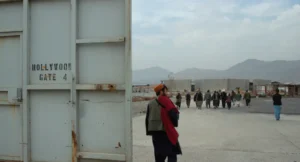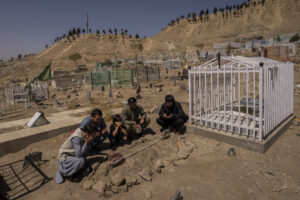The Military Industrial Complex Has Won
From our politics to our popular culture, the Pentagon now permeates every facet of American society. A proto-autocracy is the result. David B. Gleason / Flickr
David B. Gleason / Flickr
When Americans think of militarism, they may imagine jackbooted soldiers goose-stepping through the streets as flag-waving crowds exult; or, like our president, they may think of enormous parades featuring troops and missiles and tanks, with warplanes soaring overhead. Or nationalist dictators wearing military uniforms encrusted with medals, ribbons, and badges like so many barnacles on a sinking ship of state. (Was Donald Trump only joking recently when he said he’d like to award himself a Medal of Honor?) And what they may also think is: that’s not us. That’s not America. After all, Lady Liberty used to welcome newcomers with a torch, not an AR-15. We don’t wall ourselves in while bombing others in distant parts of the world, right?
But militarism is more than thuggish dictators, predatory weaponry, and steely-eyed troops. There are softer forms of it that are no less significant than the “hard” ones. In fact, in a self-avowed democracy like the United States, such softer forms are often more effective because they seem so much less insidious, so much less dangerous. Even in the heartland of Trump’s famed base, most Americans continue to reject nakedly bellicose displays like phalanxes of tanks rolling down Pennsylvania Avenue.
But who can object to celebrating “hometown heroes” in uniform, as happens regularly at sports events of every sort in twenty-first-century America? Or polite and smiling military recruiters in schools? Or gung-ho war movies like the latest version of Midway, timed for Veterans Day weekend 2019 and marking America’s 1942 naval victory over Japan, when we were not only the good guys but the underdogs?
What do I mean by softer forms of militarism? I’m a football fan, so one recent Sunday afternoon found me watching an NFL game on CBS. People deplore violence in such games, and rightly so, given the number of injuries among the players, notably concussions that debilitate lives. But what about violent commercials during the game? In that one afternoon, I noted repetitive commercials for SEAL Team, SWAT, and FBI, all CBS shows from this quietly militarized American moment of ours. In other words, I was exposed to lots of guns, explosions, fisticuffs, and the like, but more than anything I was given glimpses of hard men (and a woman or two) in uniform who have the very answers we need and, like the Pentagon-supplied police in Ferguson, Missouri, in 2014, are armed to the teeth. (“Models with guns,” my wife calls them.)
Got a situation in Nowhere-stan? Send in the Navy SEALs. Got a murderer on the loose? Send in the SWAT team. With their superior weaponry and can-do spirit, Special Forces of every sort are sure to win the day (except, of course, when they don’t, as in America’s current series of never-ending wars in distant lands).
And it hardly ends with those three shows. Consider, for example, this century’s update of Magnum P.I., a CBS show featuring a kickass private investigator. In the original Magnum P.I. that I watched as a teenager, Tom Selleck played the character with an easy charm. Magnum’s military background in Vietnam was acknowledged but not hyped. Unsurprisingly, today’s Magnum is proudly billed as an ex-Navy SEAL.
Cop and military shows are nothing new on American TV, but never have I seen so many of them, new and old, and so well-armed. On CBS alone you can add to the mix Hawaii Five-O (yet more models with guns updated and up-armed from my youthful years), the three NCIS (Naval Criminal Investigative Service) shows, and Blue Bloods (ironically starring a more grizzled and less charming Tom Selleck) — and who knows what I haven’t noticed? While today’s cop/military shows feature far more diversity with respect to gender, ethnicity, and race compared to hoary classics like Dragnet, they also feature far more gunplay and other forms of bloody violence.
Look, as a veteran, I have nothing against realistic shows on the military. Coming from a family of first responders — I count four firefighters and two police officers in my immediate family — I loved shows like Adam-12 and Emergency! in my youth. What I’m against is the strange militarization of everything, including, for instance, the idea, distinctly of our moment, that first responders need their very own version of the American flag to mark their service. Perhaps you’ve seen those thin blue line flags, sometimes augmented with a red line for firefighters. As a military veteran, my gut tells me that there should only be one American flag and it should be good enough for all Americans. Think of the proliferation of flags as another soft type of up-armoring (this time of patriotism).
Speaking of which, whatever happened to Dragnet’s Sergeant Joe Friday, on the beat, serving his fellow citizens, and pursuing law enforcement as a calling? He didn’t need a thin blue line battle flag. And in the rare times when he wielded a gun, it was .38 Special. Today’s version of Joe looks a lot more like G.I. Joe, decked out in body armor and carrying an assault rifle as he exits a tank-like vehicle, maybe even a surplus MRAP from America’s failed imperial wars.
Militarism in the USA
Besides TV shows, movies, and commercials, there are many signs of the increasing embrace of militarized values and attitudes in this country. The result: the acceptance of a military in places where it shouldn’t be, one that’s over-celebrated, over-hyped, and given far too much money and cultural authority, while becoming virtually immune to serious criticism.
Let me offer just nine signs of this that would have been so much less conceivable when I was a young boy watching reruns of Dragnet:
1. Roughly two-thirds of the federal government’s discretionary budget for 2020 will, unbelievably enough, be devoted to the Pentagon and related military functions, with each year’s “defense” budget coming ever closer to a trillion dollars. Such colossal sums are rarely debated in Congress; indeed, they enjoy wide bipartisan support.
2. The U.S. military remains the most trusted institution in our society, so say 74% of Americans surveyed in a Gallup poll. No other institution even comes close, certainly not the presidency (37%) or Congress (which recently rose to a monumental 25% on an impeachment high). Yet that same military has produced disasters or quagmires in Afghanistan, Iraq, Libya, Syria, Somalia, and elsewhere. Various “surges” have repeatedly failed. The Pentagon itself can’t even pass an audit. Why so much trust?
3. A state of permanent war is considered America’s new normal. Wars are now automatically treated as multi-generational with little concern for how permawar might degrade our democracy. Anti-war protesters are rare enough to be lone voices crying in the wilderness.
4. America’s generals continue to be treated, without the slightest irony, as “the adults in the room.” Sages like former Secretary of Defense James Mattis (cited glowingly in the recent debate among 12 Democratic presidential hopefuls) will save America from unskilled and tempestuous politicians like one Donald J. Trump. In the 2016 presidential race, it seemed that neither candidate could run without being endorsed by a screaming general (Michael Flynn for Trump; John Allen for Clinton).
5. The media routinely embraces retired U.S. military officers and uses them as talking heads to explain and promote military action to the American people. Simultaneously, when the military goes to war, civilian journalists are “embedded” within those forces and so are dependent on them in every way. The result tends to be a cheerleading media that supports the military in the name of patriotism — as well as higher ratings and corporate profits.
6. America’s foreign aid is increasingly military aid. Consider, for instance, the current controversy over the aid to Ukraine that President Trump blocked before his infamous phone call, which was, of course, partially about weaponry. This should serve to remind us that the United States has become the world’s foremost merchant of death, selling far more weapons globally than any other country. Again, there is no real debate here about the morality of profiting from such massive sales, whether abroad ($55.4 billion in arms sales for this fiscal year alone, says the Defense Security Cooperation Agency) or at home (a staggering 150 million new guns produced in the USA since 1986, the vast majority remaining in American hands).
7. In that context, consider the militarization of the weaponry in those very hands, from .50 caliber sniper rifles to various military-style assault rifles. Roughly 15 million AR-15s are currently owned by ordinary Americans. We’re talking about a gun designed for battlefield-style rapid shooting and maximum damage against humans. In the 1970s, when I was a teenager, the hunters in my family had bolt-action rifles for deer hunting, shotguns for birds, and pistols for home defense and plinking. No one had a military-style assault rifle because no one needed one or even wanted one. Now, worried suburbanites buy them, thinking they’re getting their “man card” back by toting such a weapon of mass destruction.
8. Paradoxically, even as Americans slaughter each other and themselves in large numbers via mass shootings and suicides (nearly 40,000 gun deaths in 2017 alone), they largely ignore Washington’s overseas wars and the continued bombing of numerous countries. But ignorance is not bliss. By tacitly giving the military a blank check, issued in the name of securing the homeland, Americans embrace that military, however loosely, and its misuse of violence across significant parts of the planet. Should it be any surprise that a country that kills so wantonly overseas over such a prolonged period would also experience mass shootings and other forms of violence at home?
9. Even as Americans “support our troops” and celebrate them as “heroes,” the military itself has taken on a new “warrior ethos” that would once — in the age of a draft army — have been contrary to this country’s citizen-soldier tradition, especially as articulated and exhibited by the “greatest generation” during World War II.
What these nine items add up to is a paradigm shift as well as a change in the zeitgeist. The U.S. military is no longer a tool that a democracy funds and uses reluctantly. It’s become an alleged force for good, a virtuous entity, a band of brothers (and sisters), America’s foremost missionaries overseas and most lovable and admired heroes at home. This embrace of the military is precisely what I would call soft militarism. Jackbooted troops may not be marching in our streets, but they increasingly seem to be marching unopposed through — and occupying — our minds.
The Decay of Democracy
As Americans embrace the military, less violent policy options are downplayed or disregarded. Consider the State Department, America’s diplomatic corps, now a tiny, increasingly defunded branch of the Pentagon led by Mike Pompeo (celebrated by Donald Trump as a tremendous leader because he did well at West Point). Consider President Trump as well, who’s been labeled an isolationist, and his stunning inability to truly withdraw troops or end wars. In Syria, U.S. troops were recently redeployed, not withdrawn, not from the region anyway, even as more troops are being sent to Saudi Arabia. In Afghanistan, Trump sent a few thousand more troops in 2017, his own modest version of a mini-surge and they’re still there, even as peace negotiations with the Taliban have been abandoned. That decision, in turn, led to a new surge (a “near record high”) in U.S. bombing in that country in September, naturally in the name of advancing peace. The result: yet higher levels of civilian deaths.
How did the U.S. increasingly come to reject diplomacy and democracy for militarism and proto-autocracy? Partly, I think, because of the absence of a military draft. Precisely because military service is voluntary, it can be valorized. It can be elevated as a calling that’s uniquely heroic and sacrificial. Even though most troops are drawn from the working class and volunteer for diverse reasons, their motivations and their imperfections can be ignored as politicians praise them to the rooftops. Related to this is the Rambo-like cult of the warrior and warrior ethos, now celebrated as something desirable in America. Such an ethos fits seamlessly with America’s generational wars. Unlike conflicted draftees, warriors exist solely to wage war. They are less likely to have the questioning attitude of the citizen-soldier.
Don’t get me wrong: reviving the draft isn’t the solution; reviving democracy is. We need the active involvement of informed citizens, especially resistance to endless wars and budget-busting spending on American weapons of mass destruction. The true cost of our previously soft (now possibly hardening) militarism isn’t seen only in this country’s quickening march toward a militarized authoritarianism. It can also be measured in the dead and wounded from our wars, including the dead, wounded, and displaced in distant lands. It can be seen as well in the rise of increasingly well-armed, self-avowed nationalists domestically who promise solutions via walls and weapons and “good guys” with guns. (“Shoot them in the legs,” Trump is alleged to have said about immigrants crossing America’s southern border illegally.)
Democracy shouldn’t be about celebrating overlords in uniform. A now-widely accepted belief is that America is more divided, more partisan than ever, approaching perhaps a new civil war, as echoed in the rhetoric of our current president. Small wonder that inflammatory rhetoric is thriving and the list of this country’s enemies lengthening when Americans themselves have so softly yet fervently embraced militarism.
With apologies to the great Roberta Flack, America is killing itself softly with war songs.
Your support is crucial…With an uncertain future and a new administration casting doubt on press freedoms, the danger is clear: The truth is at risk.
Now is the time to give. Your tax-deductible support allows us to dig deeper, delivering fearless investigative reporting and analysis that exposes what’s really happening — without compromise.
Stand with our courageous journalists. Donate today to protect a free press, uphold democracy and unearth untold stories.









You need to be a supporter to comment.
There are currently no responses to this article.
Be the first to respond.